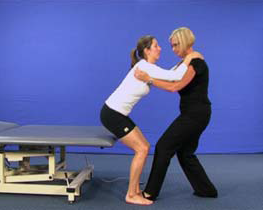AIM:
To train standing up
Rationale:
Whole-task training is set up so the patient can practice standing up with manual guidance from the therapist if necessary. Training is structured so that flexibility of performance is encouraged, ie, the cognitive and/or physical demands of the activity are increased. Two strategies are illustrated:
- manual guidance at the knee
- manual guidance at the shoulders
Equipment:
- Adjustable height plinth
- Arm sling (if necessary)
Key Points:
- Patient is positioned in sitting with < 100% thigh support, feet shoulder-width apart, knees directly over feet, ie, no hip external rotation) and ankles dorsiflexed
- Therapist is positioned to the side of the patient and provides manual guidance at the knee to bring it forwards and to assist loading
- Therapist is positioned in front of the patient provides manual guidance at the shoulders
- Patient stands up
- Ensure patient brings shoulders forwards and upwards
- Ensure patient doesn’t pause at thighs-off
Common Errors:
- Therapist stands too close to patient and blocks forward movement of the shoulders and/or knees
- Patient does not place the affected foot in sufficient dorsiflexion
- Patient fails to place sufficient weight through the affected leg
- Patient hyperextends affected knee
Progression and Variety:
- Decrease/remove manual guidance
- Decrease plinth height
- Increase speed of movement
- Increase cognitive demand
